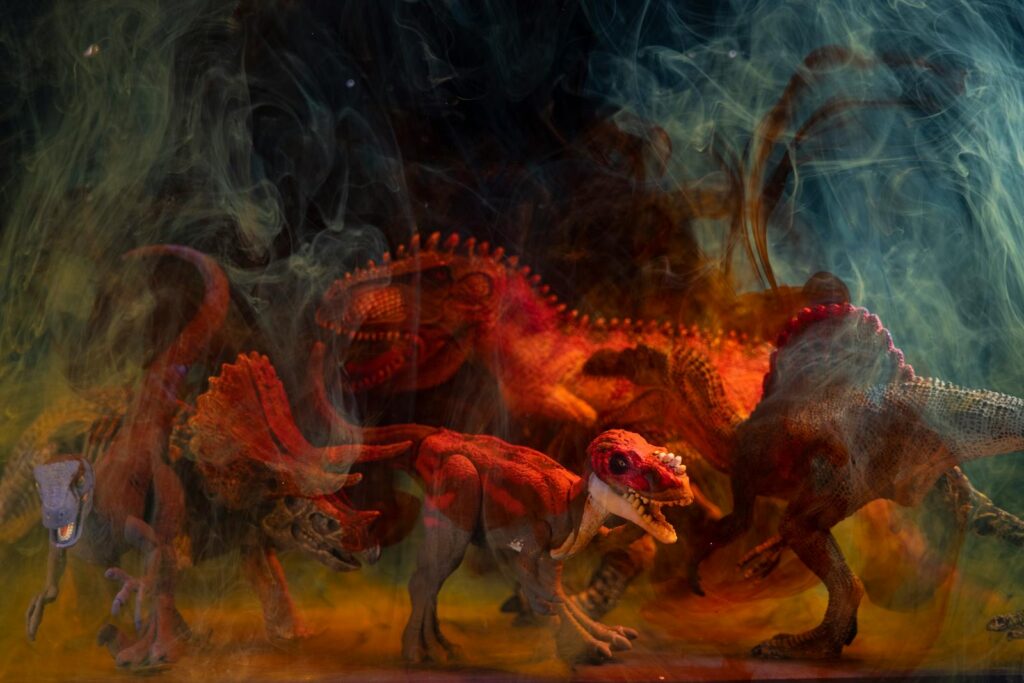When Steven Spielberg’s “Jurassic Park” roared into theaters in 1993, it did more than entertain audiences—it fundamentally transformed our collective perception of dinosaurs. Based on Michael Crichton’s novel, the film leveraged cutting-edge special effects and incorporated contemporary paleontological theories to bring prehistoric creatures to life with unprecedented realism. The impact was seismic, sending ripples through popular culture, scientific communication, and even the field of paleontology itself. Nearly three decades later, the film’s influence on how we visualize, discuss, and study dinosaurs remains profound and far-reaching.
The Pre-Jurassic Park Dinosaur Image

Before Jurassic Park revolutionized dinosaur imagery, public perception of these ancient creatures was markedly different. Dinosaurs were typically portrayed as slow, lumbering, cold-blooded reptiles—often depicted in drab colors and dragging their tails across the ground. Museum displays featured dinosaurs in upright, kangaroo-like postures that we now recognize as anatomically incorrect.
Popular culture, from children’s books to films like “The Land Before Time”, generally adhered to these outdated representations. Educational materials frequently depicted dinosaurs as evolutionary failures rather than the successful animals that dominated Earth for over 160 million years. This stagnant portrayal persisted despite paleontological evidence that had begun shifting toward a more dynamic understanding of dinosaur biology and behavior.
The “Dinosaur Renaissance” in Paleontology

Jurassic Park didn’t materialize in a scientific vacuum but rather capitalized on what paleontologists call the “Dinosaur Renaissance”—a paradigm shift in dinosaur science that began in the 1960s. Pioneered by researchers like John Ostrom and Robert Bakker, this movement proposed radical new ideas: dinosaurs were active, possibly warm-blooded animals with complex behaviors and social structures.
Evidence suggested some dinosaurs were more closely related to birds than reptiles, with Velociraptor and its relatives potentially sporting feathers. The velociraptors in Jurassic Park, while not feathered, embodied this new conception of dinosaurs as agile, intelligent, and thoroughly dangerous predators. Spielberg’s film thus served as a mainstream ambassador for these revolutionary scientific ideas that had been developing in academic circles for decades.
Groundbreaking Visual Effects That Changed Everything

The visual effects in Jurassic Park represented nothing short of a cinematic revolution, combining traditional stop-motion techniques, practical animatronics, and pioneering computer-generated imagery. Industrial Light & Magic’s digital dinosaurs—particularly the Tyrannosaurus rex and velociraptors—moved with a fluidity and naturalism that had never been achieved before. Stan Winston’s life-sized animatronic dinosaurs complemented the CGI elements, providing tangible creatures that could interact physically with the human actors.
The famous scene where the T. rex attacks the tour vehicles in the rain demonstrates a level of photorealism that left audiences and critics stunned. These technical achievements weren’t merely a spectacle; they allowed viewers to believe, perhaps for the first time, that they were seeing actual living dinosaurs. This visual credibility was crucial to the film’s impact on dinosaur perception.
The Scientific Consultant: Jack Horner’s Influence

Paleontologist Jack Horner served as the primary scientific consultant for Jurassic Park, bringing authenticity to the film’s depiction of dinosaurs. Horner was instrumental in shaping many aspects of the dinosaurs’ appearance and behavior, ensuring they aligned with contemporary scientific understanding. His research on dinosaur parental care influenced the film’s portrayal of nesting behaviors, while his expertise helped craft more anatomically accurate dinosaur designs than had previously appeared in mainstream media.
Interestingly, Horner was also the partial inspiration for the character of Dr. Alan Grant, the paleontologist protagonist played by Sam Neill. Despite these scientific contributions, Horner and the filmmakers made deliberate deviations from scientific accuracy when it served the narrative—such as making Velociraptors larger than their actual size and omitting feathers. This balance between scientific fidelity and dramatic license would become a hallmark of dinosaur media following Jurassic Park.
The Velociraptor Effect: Intelligence Reconsidered

Perhaps no dinosaur received a more dramatic image makeover from Jurassic Park than the Velociraptor, which the film portrayed as a highly intelligent pack hunter capable of complex strategies and problem-solving. The famous kitchen scene, where raptors methodically hunt the children, cemented the idea of dinosaurs as cognitively sophisticated animals rather than mindless brutes. Though the film took significant liberties—real Velociraptors were turkey-sized and almost certainly less intelligent than depicted—this portrayal sparked genuine scientific interest in dinosaur cognition and social behavior.
Following the film, paleontologists paid increased attention to the brain cases of predatory dinosaurs, using comparative neurology to make inferences about their potential intelligence. The relationship between birds and dinosaurs also gained greater focus, with researchers exploring the cognitive abilities of modern avian descendants as possible models for their Mesozoic ancestors.
Shifting Color Palettes: From Gray to Vibrant

One of Jurassic Park’s most subtle yet profound contributions was its departure from the traditionally drab color scheme assigned to dinosaurs. While still relatively conservative by today’s standards, the film’s dinosaurs featured distinctive patterning and coloration that suggested adaptation to their environments. The mottled green Tyrannosaurus, striped velociraptors, and colorful dilophosaurs challenged the long-standing assumption that dinosaur coloration could never be known and therefore should default to elephant-gray or reptilian green.
In the decades since, paleontological discoveries have validated this more colorful approach, with evidence of pigmentation preserved in exceptionally well-preserved fossils. Studies of dinosaur feathers have revealed iridescent blues, rusty reds, and patterned plumage that surpass even Spielberg’s colorful interpretations. Modern paleoart now routinely depicts dinosaurs with complex color patterns based on ecological analogues and the growing body of direct evidence.
The “Dinosaur Fever” Cultural Phenomenon

Jurassic Park triggered an unprecedented surge in public fascination with dinosaurs that extended far beyond the film itself. Museum attendance skyrocketed in the months following the film’s release, with institutions reporting visitor increases of up to 150 percent. Paleontology programs at universities saw heightened enrollment as a generation of students—many directly inspired by the film—pursued careers in dinosaur science. The merchandising juggernaut that accompanied the film placed scientifically-influenced dinosaur imagery on everything from lunch boxes to bedsheets, further cementing the new dinosaur paradigm in popular consciousness.
This “dinosaur fever” provided crucial funding and public support for paleontological research during the 1990s and early 2000s, directly contributing to significant field discoveries. The film essentially created a feedback loop where entertainment inspired scientific interest, which in turn generated new discoveries that influenced subsequent entertainment.
Influence on Museum Exhibitions and Educational Approaches

The impact of Jurassic Park rapidly transformed how museums displayed and interpreted dinosaur fossils. Traditional static skeleton mounts gave way to dynamic poses, capturing moments of predation, parental care, or locomotion. Museums invested heavily in updating their dinosaur halls to reflect both new scientific understanding and to satisfy visitor expectations shaped by the film. Interactive elements became more common, with exhibitions designed to explain the science behind the movie’s portrayal of dinosaurs.
The American Museum of Natural History’s renovation of its fossil halls in the mid-1990s exemplified this shift, featuring dramatically posed skeletons and extensive information about dinosaur biology and behavior. Educational materials for children likewise evolved, with textbooks and documentaries adopting the more active, bird-like conception of dinosaurs. Even the language used to describe dinosaurs changed, with terms like “agile,” “warm-blooded,” and “intelligent” replacing “lumbering,” “reptilian,” and “primitive.”
The Paleontology Boom: Funding and Discoveries

The unprecedented public interest in dinosaurs following Jurassic Park translated directly into increased funding opportunities for paleontological research. Private donors, corporations, and even government grants became more accessible to dinosaur researchers riding the wave of public enthusiasm. This financial windfall coincided with new technologies and methodologies in paleontology, enabling groundbreaking discoveries. The decades following the film saw the description of feathered dinosaurs from China, gigantic titanosaurs from Argentina, and miniaturized tyrannosaur relatives that revolutionized the understanding of dinosaur evolution.
Techniques like CT scanning, isotope analysis, and molecular paleontology advanced rapidly with increased resources. While these scientific developments weren’t caused by Jurassic Park, the film’s cultural impact created a supportive environment that accelerated discovery and analysis. The remarkable flowering of dinosaur paleontology in the 1990s and 2000s owes a significant debt to the popular enthusiasm generated by Spielberg’s creation.
Scientific Inaccuracies and Creative Liberties

Despite its revolutionary impact on dinosaur perception, Jurassic Park contained numerous scientific inaccuracies and creative liberties that paleontologists have discussed extensively. The most famous deviation was the significantly enlarged Velociraptor, which was actually based on the larger Deinonychus but kept the more dramatic-sounding name.
The film’s Dilophosaurus, with its neck frill and venom-spitting ability, had no basis in the fossil record but became one of the most memorable dinosaur designs in popular culture. The absence of feathers on the theropod dinosaurs represented a major omission, though at the time of production, feathered dinosaur evidence was still emerging.
The film’s premise of extracting DNA from amber-preserved mosquitoes stretched scientific plausibility, as did many aspects of the cloning process. Yet, interestingly, these inaccuracies sparked valuable public discussions about the state of paleontological knowledge and the inherent limits of reconstructing extinct animals, ultimately enhancing scientific literacy around dinosaur research.
Digital Paleontology: Computer Modeling Revolution

The groundbreaking digital effects in Jurassic Park had an unexpected consequence: they helped revolutionize paleontological methodology through computer modeling. The film demonstrated how digital technology could bring extinct animals to life, inspiring researchers to apply similar techniques to scientific questions. In the years following, paleontologists increasingly adopted 3D scanning, computational fluid dynamics, finite element analysis, and other digital approaches to study dinosaur biomechanics and behavior.
These techniques allowed researchers to test hypotheses about how dinosaurs moved, what forces their skeletons could withstand, and how they might have interacted with their environments. The distinctive walking and running animations created for the film’s T. rex, based on careful biomechanical consideration, directly influenced scientific reconstructions of dinosaur locomotion. Software initially developed for visual effects and animation found new applications in paleontological research, creating a technological bridge between entertainment and science that continues to evolve today.
The Legacy: Dinosaurs in Post-Jurassic Park Media

The portrayal of dinosaurs in all forms of media underwent a permanent transformation following Jurassic Park’s release. Documentaries like BBC’s “Walking with Dinosaurs” (1999) built upon the film’s approach, using similar CGI techniques to create immersive representations of prehistoric life based on current science. Children’s entertainment, from TV shows to toys, adopted the more dynamic, active dinosaur imagery pioneered by the film.
Scientific illustrations in textbooks and museums likewise shifted to depict dinosaurs as agile, complex animals. Even the Jurassic Park franchise itself evolved with science—later installments acknowledged feathered dinosaurs and incorporated updated paleontological concepts, though always balancing scientific accuracy with entertainment value.
Perhaps most significantly, the idea that dinosaurs were not evolutionary failures but successful, sophisticated animals that dominated Earth for far longer than humans have existed became firmly established in public consciousness. This fundamental reframing of dinosaurs as worthy of serious scientific and popular interest remains Jurassic Park’s most enduring legacy.
The Ongoing Dialogue Between Entertainment and Science

Nearly three decades after its release, Jurassic Park continues to exemplify the complex, productive relationship between entertainment media and scientific understanding. The film succeeded precisely because it took contemporary paleontology seriously while recognizing the narrative demands of thriller cinema. This approach established a template for science-informed entertainment that balances accuracy with compelling storytelling.
When new dinosaur discoveries emerge—such as evidence of feathered tyrannosaurs or the vibrant coloration of Microraptor—public interest and understanding are shaped by the visual language and concepts that Jurassic Park established. Paleontologists regularly engage with the film’s legacy, using its widespread cultural recognition as a starting point for discussing actual dinosaur science. Many admit to being inspired by the film themselves, even as they work to correct its scientific shortcomings.
This ongoing conversation between entertainment and science demonstrates how popular media can both reflect and drive scientific progress, with each new discovery and depiction building upon the revolutionary foundation that Jurassic Park established.
Conclusion

Jurassic Park forever altered our relationship with dinosaurs, transforming them from museum curiosities into dynamic, compelling creatures that capture scientific and popular imagination alike. The film bridged entertainment and paleontology in unprecedented ways, amplifying the “Dinosaur Renaissance” already underway in scientific circles and bringing it dramatically into public consciousness. While not without scientific compromises, Spielberg’s vision catalyzed genuine advances in paleontological research, museum design, and educational approaches.
Perhaps most importantly, it helped us recognize dinosaurs not as evolutionary failures but as extraordinary animals whose 165-million-year reign dwarfs our own brief history. When we envision dinosaurs today—whether in museums, documentaries, or our imagination—we see them through a lens that was fundamentally reshaped by that groundbreaking film from 1993, a testament to cinema’s unique power to transform how we perceive our world and its distant past.




